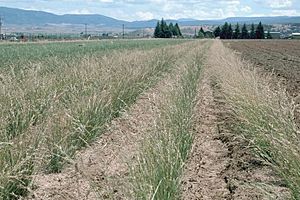Mountain brome facts for kids
Quick facts for kids Mountain brome |
|
|---|---|
 |
|
| Conservation status | |
| Scientific classification | |
| Genus: |
Bromus
|
| Species: |
marginatus
|
Bromus marginatus, also known as mountain brome, is a type of grass. It grows naturally in western North America. This grass is very useful for feeding grazing animals like cattle. It is also used to help land recover after disturbances, like fires or construction.
What it Looks Like
Mountain brome is a grass that lives for several years, but not forever. It has a wide, shallow network of roots. These roots help the plant survive when there isn't much water, making it good at handling drought. Even after the plant dies, its roots stay in the soil. This helps to stop the soil from washing away, which is called erosion control.
The stems of mountain brome usually grow about one meter (about 3 feet) tall. Some can even reach 1.5 meters (about 5 feet). Its leaves are hairy and can be up to a centimeter wide. The plant's flowers grow in a group called an inflorescence. This flower cluster is a nodding panicle, which means it hangs down. Each panicle has many small parts called spikelets, and each spikelet can have up to 10 flowers.
Where it Grows
In the wild, mountain brome likes to grow in damp areas. You can find it in mountain sagebrush areas, scrublands, and meadows. It can grow even in very high, cool places, like the subalpine climate zone. This grass can grow in thin, dry soils and can even handle some shade.
It's easy for mountain brome to start growing in new places. Sometimes, it can even spread so much that it becomes a bit "weedy." Farmers and land managers can plant this grass on hills and bumpy ground. They often use a method called broadcast seeding, which means scattering the seeds widely.
Different Types of Mountain Brome
There are several special types of mountain brome that people have developed. These are called cultivars. Some well-known cultivars include 'Garnet', 'Bromar', and 'Tacit'. The 'Tacit' type is known for growing a lot of grass. It can produce about 15 tons of grass per hectare (a hectare is about 2.5 acres) each year. Farmers can usually harvest it 3 to 4 times a year.
See also
 In Spanish: Bromus marginatus para niños
In Spanish: Bromus marginatus para niños


